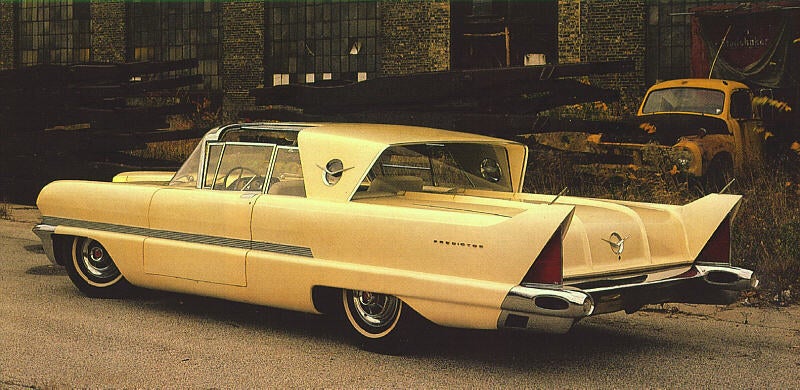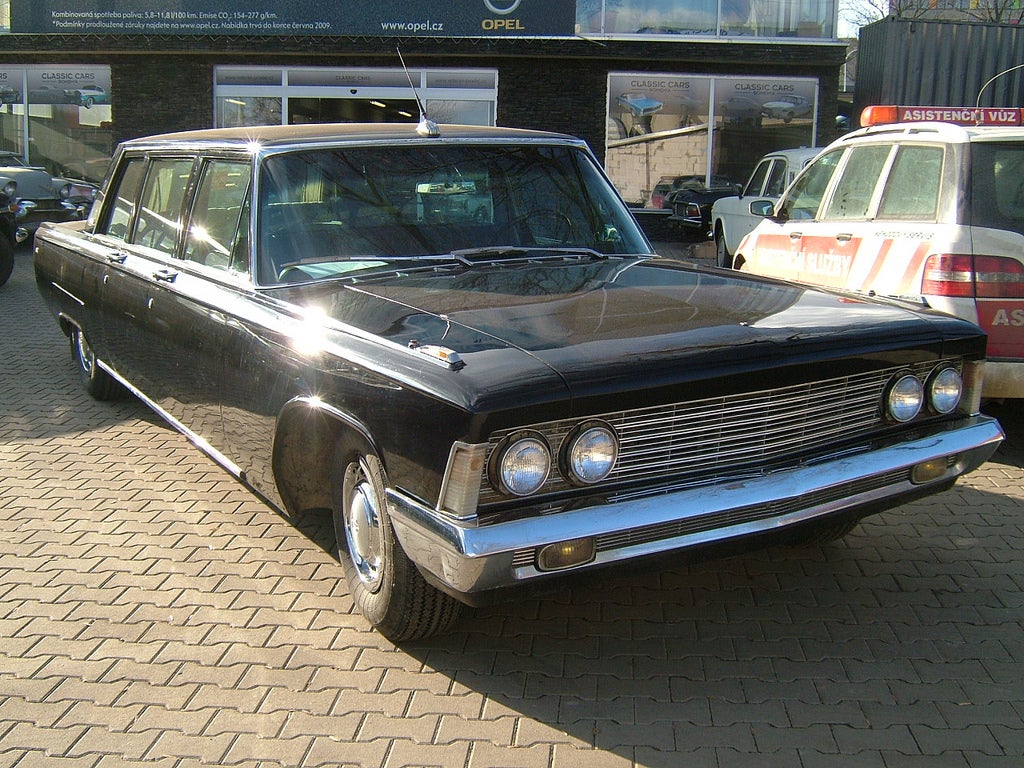 "JR1" (type35bugatti)
"JR1" (type35bugatti)
05/06/2015 at 08:48 • Filed to: Packard
 1
1
 18
18
 "JR1" (type35bugatti)
"JR1" (type35bugatti)
05/06/2015 at 08:48 • Filed to: Packard |  1 1
|  18 18 |

As we all know Packard went out of business in the 1950’s after a shaky merge with Studebacker. In hindsight Packard likely would have been better off finically if it did not merge with dying Studebacker.
Even if it had not merged Packard was still in very poor shape in the 1950’s. Could anything have saved it like this 1956 Packard Predicator concept car? Or was Packard always doomed to fail regardless of what it did?
 pip bip - choose Corrour
> JR1
pip bip - choose Corrour
> JR1
05/06/2015 at 08:52 |
|
doomed.
 505Turbeaux
> JR1
505Turbeaux
> JR1
05/06/2015 at 08:52 |
|
this was back before “Too Big To Fail” was part of the American financial lexicon or there would have been found money waiting to bail them out.
 RamblinRover Luxury-Yacht
> JR1
RamblinRover Luxury-Yacht
> JR1
05/06/2015 at 09:01 |
|
As much as Packard was the absolute acme of American luxury makes, any big company that had taken them under their wing would have had to make room in the stable. Cadillac was very directly a competitor, Lincoln was on the ascendancy, and Chrysler was busy sort-of spinning off Imperial as a premier brand. None of them would have been interested. On the other hand, what did almost happen (a merger with the nascent AMC out of Nash Kelvinator and Hudson) would have competed with nothing in-house at all. The out-of-mainstream, quirky, small-production nature of AMC would have been served well by having a low production extreme luxury brand, but might in time have gotten bastardized like other AMC brands did. Still, it makes the most sense - James Nance of SPC seems to have made a mistake in insisting he’d be the head of such a business, which killed any plans to do it in the cradle. That, I didn’t know. Packards with reworked AMC V8s would at least have been possible to build at less than murderous expense.
 Cé hé sin
> JR1
Cé hé sin
> JR1
05/06/2015 at 09:13 |
|
If that’s the kind of thing they were making they definitely shouldn’t have been saved...
 ADabOfOppo; Gone Plaid (Instructables Can Be Confusable)
> JR1
ADabOfOppo; Gone Plaid (Instructables Can Be Confusable)
> JR1
05/06/2015 at 09:40 |
|
Sadly, no.
They could have gotten a few more years without the Studebaker merger, but without the massive capital available to Cadillac and Lincoln they could not have hoped to innovate and update their products quickly enough to compete.
Without their early demise, Packard of the late 1950's and early 1960's would be very much like Lincoln is today; an afterthought selling inferior products waiting for a flagship to harken back to their glory years.
If by some magical power Packard had managed to weather the 60s, the gas crisis would have certainly done them in.
 ly2v8-Brian
> JR1
ly2v8-Brian
> JR1
05/06/2015 at 09:58 |
|
Didn't help that there was a recession during that time.
 boobytrapsandtreasure
> JR1
boobytrapsandtreasure
> JR1
05/06/2015 at 10:19 |
|
Sadly, no. But the name could be brought back at some point.
 JR1
> RamblinRover Luxury-Yacht
JR1
> RamblinRover Luxury-Yacht
05/06/2015 at 14:00 |
|
It sounds like you think an AMC merge might have worked. And I tend to agree. At least for a little while longer.
Do if they would have stayed independent there would have been any hope for the brand?
 JR1
> ADabOfOppo; Gone Plaid (Instructables Can Be Confusable)
JR1
> ADabOfOppo; Gone Plaid (Instructables Can Be Confusable)
05/06/2015 at 14:01 |
|
You are right that gas crisis would have killed off any hope for the brand probably.
 JR1
> Cé hé sin
JR1
> Cé hé sin
05/06/2015 at 14:02 |
|
You don’t like that? I think it is a nod to the town cars of the 20s/30s I really like it.
 JR1
> ly2v8-Brian
JR1
> ly2v8-Brian
05/06/2015 at 14:02 |
|
That recession hurt a lot of luxury brands in the late 50s
 RamblinRover Luxury-Yacht
> JR1
RamblinRover Luxury-Yacht
> JR1
05/06/2015 at 14:15 |
|
Well, considering that a large part of what killed them was falling behind fashion, and that the fix to that was infrastructure investment and retooling that they ended up half-assing, the only way continued independence would have worked would have been attracting quite a lot of investment. If they’d stayed independent long enough to join AMC without the Studebaker baggage... maybe. The trouble there was that they got only just enough reinvestment to continue in the Studebaker project, not enough to thrive, and lost independence in exchange for shackling themselves to what was already on track to become dead weight. If they’d been desperate enough (after holding out longer) to adopt a Nash/Hudson/etc. bid without holding out for a better deal, they might have gone forward with fewer strings attached and thrived, maybe even as late as 1980 or later.
I’m not sure whether the reinvestment/”help” from Studebaker actually made revitalizing Packard a harder prospect from an investor’s standpoint or a better one. I bet George Romney ran the numbers on one side of that and would have known - he may have even written about it, since with Nance being unreasonable and greedy (the problem of hiring a “golden boy” type as CEO) Romney was the one who had to say “No, no mergers for now”. I’m sure he’d have loved to turn around the Packard line much like he did Rambler, and he wouldn’t have cheapened it any more than Nance did - but with S-P’s insistence on being treated as an equal or superior with poor capitalization and coming late to the table...
 ly2v8-Brian
> JR1
ly2v8-Brian
> JR1
05/06/2015 at 16:39 |
|
Absolutely, and it really crippled the smaller manufacturers.
 ranwhenparked
> JR1
ranwhenparked
> JR1
05/06/2015 at 23:58 |
|
They might have survived a bit longer, but the future was anything but secure for them as an independent company. Packard had a healthy credit rating and minimal debt, but they were losing money, their sales were in free fall, and they were struggling to get the finances together to launch new models on a reasonable schedule. The production restrictions during the Korean War hurt them worse than the Big Three, and the aggressive postwar price war between GM and Ford hurt them even more. Then, there was the bungled move of their assembly lines to the Conner Avenue body plant to consolidate production on one site. It might have saved money eventually, but they had to buy out that plant with funds they couldn’t really afford to lose, and the move delayed the launch of their 1955 models, leaving them nothing to sell in the interim. When the ‘55s did finally go on sale, the factory experienced severe “teething” issues - output was way below what it should have been, causing frustrated customers to go to Cadillac, Lincoln, or Imperial, and the cars that did roll off the line suffered serious quality control problems to the point that many of the ones that made it to dealers couldn’t be easily fixed to saleable condition. Packard’s reputation took another serious hit.
You could argue that maybe if they hadn’t bought Studebaker, Packard might have been in a position to better manage the move to Conner Ave, or they might not have been as urgent in their push to consolidate assembly and body production (though it did make a lot of sense on paper), but I think you would have been talking more about buying years, not decades. Ultimately, it was Packard’s management that made all those calls and presided over that whole disaster, and they were the ones that would have been running an independent Packard as well.
What might have worked would have been if they had joined Hudson and Nash-Kelvinator to become American Motors’ luxury division. However, in 1954, the small car sales boom that would make Rambler the #3 brand in America was still several years off, and due to Studebaker’s financial misrepresentations, they seemed on the surface to be a more secure merger partner than Hudson, which was in such bad shape, it really did seem like it might sink Nash.
 ranwhenparked
> RamblinRover Luxury-Yacht
ranwhenparked
> RamblinRover Luxury-Yacht
05/07/2015 at 00:04 |
|
Dick Teague could work wonders on a shoestring budget. The 1955 Packards did pretty much catch up to Cadillac and Lincoln in the styling department, and were right up to the minute in fashion - BUT, they were still essentially a very heavy facelift of an old body shell, since Packard still couldn’t afford to do a new one. There was a hard limit on how many more times they would have been able to do that. No way that obviously rounded ‘50s shape could have been nipped and tucked to fit in with the squarer, plainer look that came in in the early ‘60s, and I really don’t see how it was going to ever sell in numbers big enough to fund it’s own replacement - Imperial couldn’t do it without subsidies from Chrysler Corp., and Lincoln was in pretty much the same boat in the ‘50s.
 RamblinRover Luxury-Yacht
> ranwhenparked
RamblinRover Luxury-Yacht
> ranwhenparked
05/07/2015 at 08:50 |
|
Exactly. Packard needed to be the recipient of a larger company’s beneficence, and Studebaker wasn’t it.
 JR1
> ranwhenparked
JR1
> ranwhenparked
05/07/2015 at 10:17 |
|
I forgot the move to the Packard plant did so much to screw Packard.
It is unfortunate poor mismanagement and things like the price war were killed off the brand. Even if they would have weathered the storm and merged to form AMC I can’t help but wonder if they would have hurt AMC more with the recession in the late 50’s.
 MultiplaOrgasms
> JR1
MultiplaOrgasms
> JR1
05/07/2015 at 10:57 |
|
In some ways Packard did live on...
